Real estate email marketing is a game-changer for your business, but with so many moving parts and new strategies, it can be tough to know where to start or how to level up your existing email game. Email marketing is my jam, so I’ve put together this ultimate guide to email marketing for real estate agents. Whether you’re a total newbie or a seasoned pro, you’ll find plenty of actionable tips, tools, and tactics to help you crush your email goals and take your business to new heights. Ready to rock? Let’s do this!
Why Email Marketing Is Essential for Your Real Estate Business
If you’re not using email marketing to connect with your leads, stay in touch with your sphere of influence, and nurture those precious new leads you worked so hard to generate, you’re missing a massive opportunity. Email marketing for Realtors is like the secret weapon of real estate marketing materials—it’s personal, cost-effective, and, best of all, unlike social media platforms, your email database belongs to you.
Email lets you contact each person in your database individually, making them feel like you’re speaking directly to them. It’s like having a one-on-one conversation with your leads. Plus, consistently staying in touch with your entire database ensures that none of your valuable leads slip through the cracks.

Email marketing is also known for its sky-high return on investment (ROI) and converts 40% higher than social media. That’s right—you can get more bang for your buck with email than with just about any other marketing strategy. As consumer preferences and technology evolve, email real estate marketing is adapting along with them, ensuring you can always reach your audience where they are.
So, if you want to build lasting relationships, stay top-of-mind with your leads, and get the most out of your marketing budget, email marketing is the way to go. Trust me.
Glossary of Email Marketing Terms for Realtors
Let’s start with some standard terms every real estate pro should familiarize themselves with in the real estate marketing email space. Here is a list of terms that are common among email marketing aficionados.
- List: Your list of email subscribers. Also known as your database.
- Subscribers: The people who have chosen to receive marketing emails from you usually through an opt-in form.
- Subject line: The brief text displayed in a recipient’s inbox before it’s opened.
- Preheader or preview text: The short preview of the email message below the subject line before opening the full email.
- Spam: Bulk or unsolicited marketing email sent to someone without their consent.
- Opt-in: When a person voluntarily subscribes to your email list.
- Opt-out: When a person unsubscribes from your email list.
- Open rate: The percentage of recipients who opened your email calculated by dividing the number of opened emails by the total number of delivered emails. Bounced emails are not included in the calculation for open rates.
- Click-through rate (CTR): The percentage of recipients who click on a link inside your email from the number of emails delivered.
- Click-to-open rate (CTOR): The percentage of recipients who opened an email and then clicked a link from the number who opened the email.
- Bounce rate: The percentage of emails that couldn’t be delivered to recipients’ inboxes.
- Conversion rate: The percentage of email recipients who complete a desired action, such as filling out a form, joining your email list, or making a purchase.
- A/B testing: A method of comparing two versions of an email to determine which one performs the best.
- Drip campaign: A series of automated emails sent to subscribers over time based on specific timelines or user actions.
- Segmentation: Dividing your email list into smaller groups based on specific criteria, such as demographics or behavior.
- Personalization: Customizing email content for individual recipients based on their preferences, behavior, or other data.
- Merge field: A dynamic placeholder in an email template that automatically populates with specific data when the email list is sent (example: {first name}).
- Call to action (CTA): A button or link within an email that encourages the recipient to take a specific action, such as “Book a showing” or “Download my guide.”
7 Steps to Create Your Real Estate Email Marketing System
Now that we’ve covered the fundamentals of real estate email marketing, let’s dive into the practical steps you can take to create a comprehensive and effective email marketing system for your business.
1. Build Your Real Estate Email List
First things first, you need to have a game plan for capturing leads and growing your subscriber base. You can utilize opt-in forms, landing pages, lead magnets, and more. And be sure to let your potential subscribers know what’s in it for them—exclusive listings, neighborhood guides, or homebuying tips. Ensure your opt-in forms highlight the value you deliver straight to their inbox, and you’ll grow your list in no time. Here are a few ideas.
Strategically place opt-in forms on your website and landing pages
- Make it easy for visitors to sign up for your email list
- Highlight the value subscribers will receive (exclusive listings, neighborhood guides, homebuying tips)
Create several landing pages with valuable lead magnets
- Real estate landing pages convert at an average of 4.6%
- Well-designed landing pages help build your list faster
- Lead magnets—content your target audience would exchange their name and email for (I love Canva for these!)
Leverage social media and online advertising to attract subscribers
- Share snippets of your email content on social media channels
- Include a link to your opt-in form for easy sign-up
- Run targeted ads on platforms like Facebook and Instagram
- Offer a valuable resource in exchange for signing up (free home valuation, buyer’s guide)
Utilize offline methods for collecting email addresses
- Capture email addresses at open houses, community events, and casual meetings
- Use sign-up sheets, business card raffles, or simply ask to join your email list
Building your email list is an ongoing process
- Consistently employ these strategies to create a thriving, engaged subscriber base
Create valuable lead magnets to build a subscriber base of ideal clients
- Couple lead magnets with landing pages (third-party or built-in customer relationship management (CRM) pages)
- Lead magnets feed information directly into your database

Remember, building your email list is an ongoing process. But with these strategies in your toolbox, you’ll be well on your way to creating a thriving, engaged subscriber base excited to hear from you.
Spend time creating valuable resources you can use as lead magnets—pieces of content your target audience would gladly exchange their name and email for (check out my example below). Couple these lead magnets with landing pages—you can use a third party like LeadPages, or some CRMs have built-in landing pages that feed information directly into your database—to build a subscriber base of your ideal clients.

2. Segment Your Contacts for Targeted Messaging
Here’s the truth: If you’re not segmenting your email list, you’re doing it wrong. Segmentation is the key to sending targeted, relevant messages that resonate with your audience. When your emails hit your target segment, you’ll see better open rates, click-through rates, and, ultimately, more business.
So, what exactly is list segmentation? It’s dividing your email list into smaller groups based on specific criteria, like buyer persona, location, or stage in the buying/selling process. By creating these targeted segments, you can craft email content that speaks directly to each group’s unique needs, interests, and pain points.
Here are a few ways to segment your database:
- Segment by buyer persona: Create segments for first-time homebuyers, investors, luxury buyers, or other relevant buyer personas. Tailor your content to each group’s questions, concerns, and information needs. (You can use this strategy for seller personas too).
- Segment by location: If you’re working in multiple neighborhoods or cities, segment your list by geographic location to send hyper-local content that resonates with each audience. Highlight neighborhood events, showcase local market stats, or feature properties specific to each area.
- Segment by stage in the buying/selling process: Create segments for leads who are just starting to explore their options, those who are ready to make an offer or list their home, and everyone in between. Deliver the right message at the right time to nurture your leads and guide them through the process.

Honestly, list segmentation is pivotal for real estate email marketing. By taking the time to create targeted segments and crafting content that speaks to each group’s individual needs, you’ll be able to:
- Build stronger relationships with your leads and clients
- Establish yourself as a trusted resource and authority in your market
- Increase your email open rates, click-through rates, and conversions
- Close more deals and grow your business
So, start segmenting your database into meaningful groups, and watch your email marketing results take off.
3. Craft Engaging Email Content
Now that you’ve got your email list segmented and ready to go, it’s time to focus on creating email content that will keep your subscribers engaged, informed, and eager to hear from you. Mixing up your email types, nailing your subject lines and copy, and adding some visual flair to your messages will keep your emails engaging for your readers.
Use the Power of Subject Lines to Get Your Emails Opened
When it comes to email marketing, your subject line is the gateway to your content. It’s the first thing your subscribers see in their inbox, and it’s the most important factor in determining whether they’ll open your email. In fact, 47% of email recipients decide whether to open an email based on the subject line alone. That means if your subject line falls flat, the rest of your carefully crafted email might as well be invisible.

So, how do you write subject lines that stand out, pique your readers’ interest, and compel them to click? Here are a few tips and examples to get you started:
- Keep it short and sweet: Aim for 50 characters or less (or six to 10 words) to ensure your subject line isn’t cut off on mobile devices. Example: “5 Must-See Listings in [Neighborhood]”
- Use action-oriented language: Start your subject line with a verb to create a sense of urgency and excitement. Example: “Discover Your Dream Home: New Listings Inside”
- Personalize when possible: Use merge fields to include your readers’ names or locations in your subject lines. Example: “[First Name], Your [City] Market Update Is Here”
- Highlight benefits and value: Focus on what’s in it for your subscribers, whether it’s exclusive information, insider tips, or special offers. Example: “Insider Tips: How to Price Your Home for a Quick Sale”
- Ask questions: Engage your subscribers by asking questions related to their needs or interests. Example: “Thinking of Selling? Here’s What Your Home Is Worth Now”
- Create a sense of scarcity or urgency: Use words like “limited time,” “last chance,” or “only X spots left” to encourage readers to act fast. Example: “Last Chance: Register for Our Homebuyer Seminar”
- Test, test, test: Try out different subject line formats, lengths, and styles to see what resonates best with your audience. Use A/B testing to compare two versions and let the data guide your decisions.
- Leave out the emojis: Research shows that emojis in subject lines increase negative sentiment toward email by 26% and do not increase the likelihood of subscribers opening an email.
It’s a common adage among email marketers that you should spend twice as much time writing your subject line as you do on the email content itself. The subject line is your one shot to make a great first impression and convince your subscribers to open your email. So, put yourself in their shoes, think about what would grab your attention, and craft subject lines that are impossible to ignore.
By mastering the art of the subject line, you’ll be able to boost your open rates, get more eyes on your content, and, ultimately, drive more leads and sales for your real estate business.
📌 Pro Tip
Retention Science found that subject lines with movie titles and song lyrics have an average open rate of 26%. (Ex: Don’t Stop Believin’ in your dream home – open house this weekend!)
Send a Variety of Email Types to Keep Your Readers Hooked
Let’s talk about the types of emails you should be sending. A well-rounded email marketing strategy will include various email types designed to serve a specific purpose. Here are a few essential email types to consider:
- Newsletters: Keep your readers in the loop with regular newsletters featuring industry news, market updates, and helpful tips for buyers and sellers.
- Market updates: Showcase your local market expertise by sending targeted market reports and analyses to your sellers and past clients.
- Listings: Highlight your latest listings, open houses, and recently sold properties to generate buzz and drive traffic to your website.
- Educational content: Share your knowledge and establish yourself as a trusted resource by sending educational content like homebuyer guides, seller tips, or neighborhood spotlights.
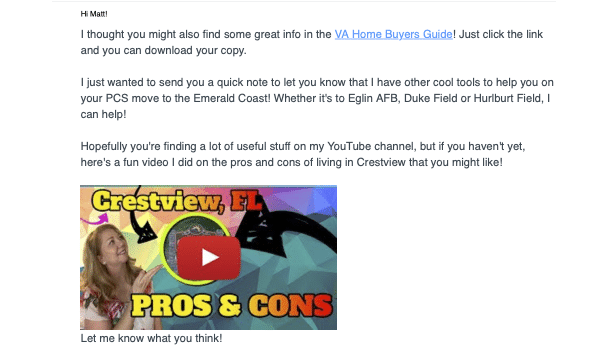
Crafting engaging email content is more than just choosing the right email type. You must also master writing compelling copy and calls to action (CTAs). Here are a few best practices to remember:
- Copy: Write subject lines and copy that are clear, concise, and focused on the benefits for your readers. Use a conversational tone, break up your text with short paragraphs and bullet points, and always proofread before hitting send.
- CTAs: Every email should have a clear, enticing call to action that tells your readers what you want them to do next. Whether it’s “Schedule a showing” or “Download our free guide,” make sure your CTAs are prominent, easy to click, and aligned with your email’s overall goal. You might even try a button.
Increase Engagement With Visuals & Personalization
Incorporate visuals and interactive elements to take your email content to the next level. Adding images, videos, or GIFs can help break up your text, showcase your listings, and inject some personality into your emails. Interactive elements like surveys, polls, or quizzes can also help boost engagement and gather valuable insights from your subscribers.
Remember the power of personalization. By using merge fields to include your subscribers’ names, segmenting your list to deliver targeted content, and crafting copy that speaks directly to your reader’s needs and interests, you can create emails that feel less like generic blasts and more like one-on-one conversations.
Crafting engaging email content is both an art and a science. By experimenting with different email types, honing your subject lines and copy, and adding visual and interactive elements to your messages, you’ll be able to create emails that your subscribers can’t wait to open. So, get creative, stay focused on your goals, and watch your email engagement soar.
📌 Pro Tip
The sender’s name and subject line are the most important factors in getting your emails opened and read
4. Utilize Real Estate Email Marketing Campaigns
Now that you’ve got the fundamentals of email content creation down, it’s time to explore specific strategies and campaigns that can help you nurture leads, promote your listings, and keep your subscribers engaged.
From nurture campaigns to seasonal promotions, there’s an email strategy for every stage of the real estate journey. Here are campaign ideas you can use:
- Nurture: A series of emails designed to guide your leads through the buying or selling process, providing them with the information and support they need at each funnel stage.
- Promotional: One-off emails designed to generate buzz and drive action around a specific event or offer.
- Seasonal: Meant to engage your subscribers and show off your personality. From “Treat yourself to a new home this Halloween” to “Fall in love with these cozy winter listings,” there are endless opportunities to get creative with your email marketing throughout the year.
- Referral and testimonial: A powerful way to leverage social proof and grow your business. Encourage your satisfied clients to refer their friends and family. And don’t forget to showcase your glowing testimonials and success stories in your emails to build trust and credibility with your subscribers.
- Re-engagement: These campaigns engage inactive subscribers and can help you win back those who haven’t opened your emails in a while. They keep your list healthy and engaged.
So, experiment with different campaign types, get innovative with your content, and always keep your subscribers’ needs and interests as a priority. With a little effort and a lot of heart, you can create real estate email marketing magic.
To learn more about each type of drip campaign above and see samples, visit our article, Real Estate Drip Campaigns: The Complete Guide.
5. Incorporate Video to Supercharge Your Emails
If you’re looking to take your email marketing to the next level, one tool that you absolutely need in your arsenal: video. Adding video to your emails creates a more engaging, memorable, and personal experience for your subscribers, setting you apart from the competition.
Why is video so effective in email marketing? Real estate is highly visual, for starters. Plus, it’s a great way to humanize your brand and build a stronger connection with your audience. When your readers can see your face and hear your voice, they’re more likely to feel like they know, like, and trust you—essential for building long-term relationships and driving your real estate closings.
Video is a highly engaging medium to help your emails stand out in a crowded inbox. According to a recent study, including “video” in the subject line increases open rates by 6%. That means more subscribers are consuming your content and taking action on your messages.
📌 Pro Tip
Real estate companies are creating 132% more videos, 155% more user-generated videos, and 90% more produced videos
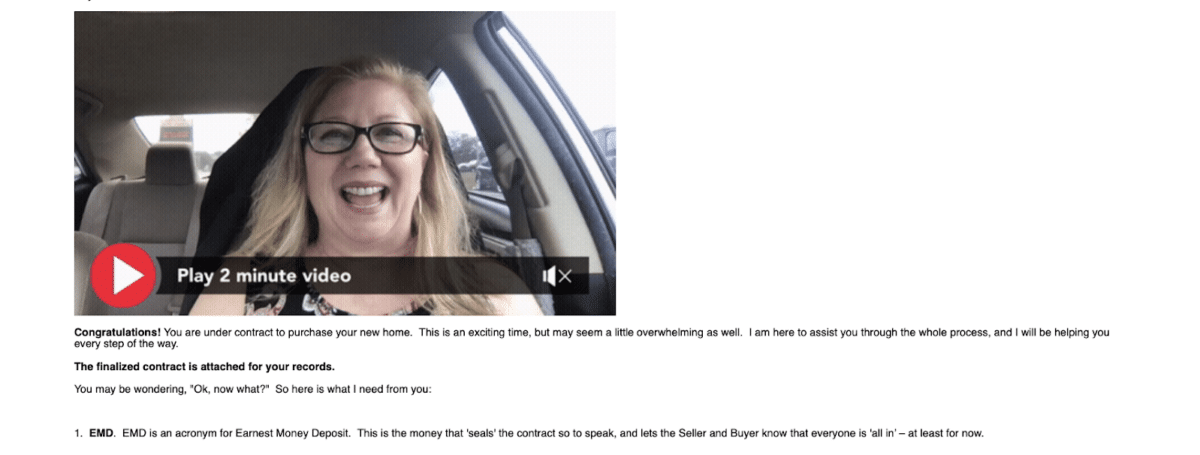
So, how can you start incorporating video into your email marketing for real estate? One easy way is to use a tool like BombBomb, which allows you to create and embed videos directly into your emails. With BombBomb, you can record personalized video messages for your readers, showcase your listings with video tours, and even create video drip campaigns that nurture your leads over time. I love how BombBomb makes GIFs out of the video so it’s more attractive to the reader, enticing them to click it.
6. Automate Email Sends
Email automation is where the real magic happens, and agents save time, streamline their communication, and deliver the right message to the right person at the right time. By setting up automated email sequences and campaigns, you’ll generate new leads, nurture your potential buyers and sellers already in the pipeline, keep your clients engaged, and drive more business.
Email marketing automation involves creating prewritten emails sent automatically to your database based on specific triggers or timelines. This email send could be a welcome sequence that introduces new leads to your brand, a drip campaign that nurtures prospects over time, or an event-based email triggered by a specific behavior or milestone. By consistently providing valuable content to your email list, you can build trust, establish your expertise, and be top-of-mind when those leads are ready to make a move.
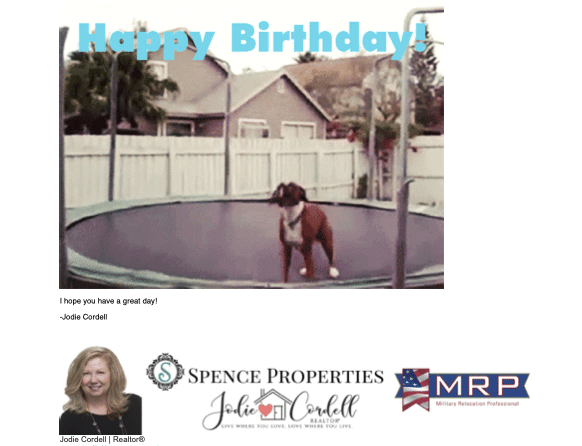
Integrating your email marketing tool with your customer relationship management (CRM) system is essential to get the biggest bang for your buck. Platforms like Follow Up Boss, Wise Agent, and Top Producer offer seamless integrations that allow you to:
- Automatically sync your contacts and lead information
- Trigger emails based on lead behavior or stage in the sales funnel
- Track email engagement and use that data to inform your follow-up
- Personalize your emails with content based on lead preferences or behavior
- Convert more leads into closed deals
So, whether you’re setting up a simple welcome sequence or a complex, multi-step drip campaign, email marketing automation is an essential tool for any real estate agent looking to grow their business and deliver an exceptional client experience.
7. Measure & Optimize Email Performance
To optimize email marketing performance, tracking key metrics and continuously refining your strategy based on data insights is crucial. By regularly tracking these metrics, you can identify areas for improvement and make data-driven decisions to enhance your email performance.
These are the most important metrics to monitor:
- Open rate
- Click-through rate (CTR)
- Conversion rate
A/B Testing
One effective way to optimize your emails is through A/B testing. This strategy involves creating two slightly different versions of an email element (such as a subject line or call to action) and sending each version to a small subset of your list to see which one performs better. You can continuously refine your email strategy and improve your marketing performance by testing different elements and analyzing the results.
Email marketing requires ongoing monitoring, testing, and optimization to be truly effective. By staying data-focused and continuously improving your approach, you can create email campaigns that drive real results for your real estate business.
Top Email Marketing Tools for Real Estate Agents
As a real estate agent, having the right email marketing tools can make a huge difference in your ability to connect with leads, nurture relationships, and ultimately close more deals. Many tools offer free trials, so take advantage of these to test different platforms and find the one that best fits your needs and budget.
When choosing an email marketing tool, consider these factors:
- Ease of use
- Automation capabilities
- Integration with your existing website and CRM
- Pricing
By selecting the right email marketing tool and integrating it with your other real estate tech stack, you’ll be able to streamline your marketing efforts, save time, and grow your business. So, don’t be afraid to experiment with different tools until you find the perfect fit. Let’s look at some of the top real estate-specific email marketing platforms:
| BombBomb | Unique platform allows you to easily create and embed personalized videos into your emails, helping you stand out and build stronger connections with your leads and clients. Integrates with many real estate-specific platforms, including Follow Up Boss, Wise Agent, Real Geeks, and more. |
| Happy Grasshopper | Designed specifically for real estate agents, Happy Grasshopper offers prewritten email campaigns, lead nurturing automation, and integrations with popular real estate CRMs like Follow Up Boss and Wise Agent. |
| Wise Agent | More than just an email marketing tool, Wise Agent is an all-in-one real estate CRM that includes email marketing, contact management, and transaction management capabilities. |
| Real Geeks | While primarily a lead generation and website platform, Real Geeks also offers email marketing tools that integrate seamlessly with their CRM, allowing you to manage and nurture your leads easily. |
| Top Producer | Another comprehensive real estate CRM, Top Producer includes email marketing features like drip campaigns and mobile-responsive templates, as well as integrations with platforms like BombBomb. |
| Sierra Interactive | This real estate marketing platform offers a range of tools, including email marketing, lead generation, and a CRM, all designed to help agents grow their businesses. |
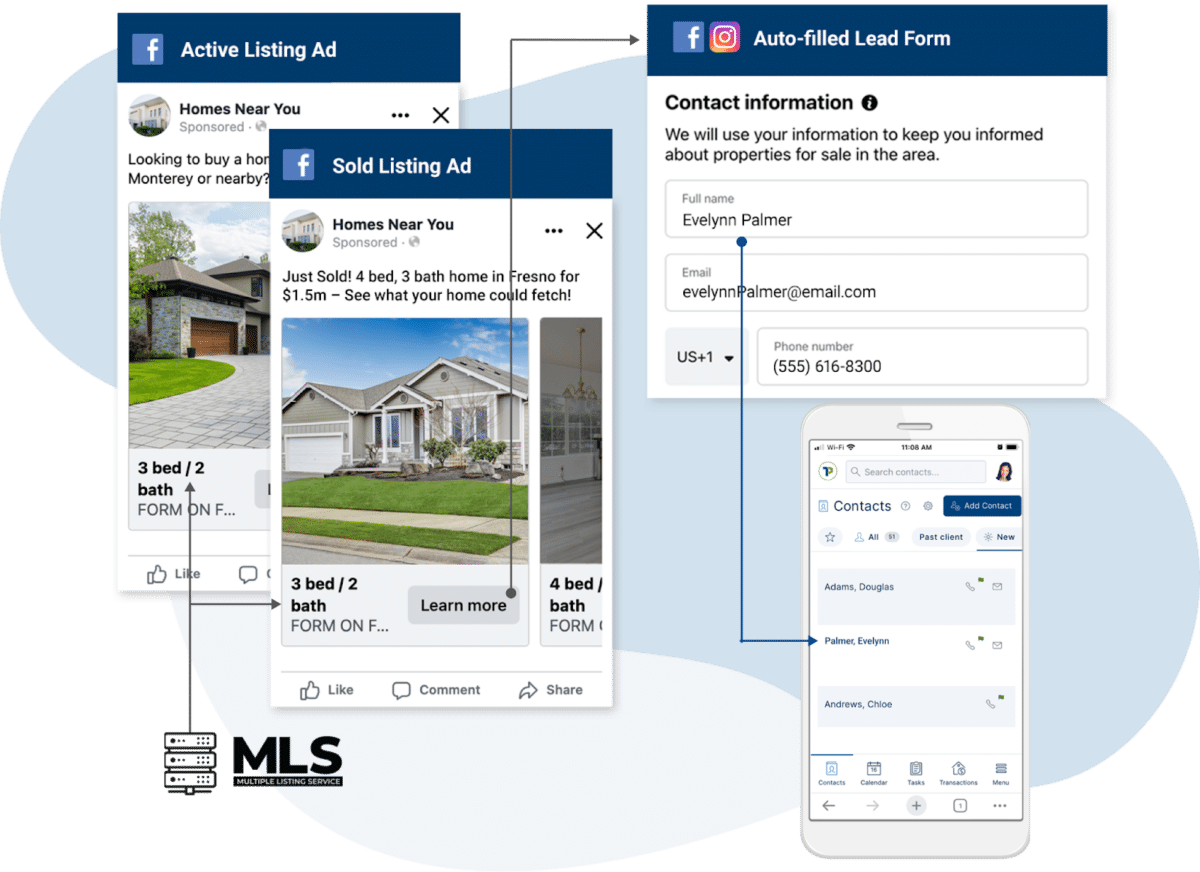
Grow your database with a steady stream of affordable, exclusive real estate leads from social media ads. Social Connect from Top Producer is designed to get you a high volume of leads and move them through your pipeline until they’re ready to buy and sell real estate. Connect with an average of 30 consumers interested in real estate in your local market for just $300 per month!
How Social Connect works:
Email Best Practices & Compliance
To maximize the success of your email marketing for real estate, follow these best practices and legal requirements:
- Mobile-friendly and accessible: Use responsive design templates to ensure your emails look great on any device.
- Anti-spam laws and regulations: Adhere to laws like CAN-SPAM and GDPR, which require accurate sender information, clear unsubscribe options, and prompt handling of opt-out requests.
- List hygiene and unsubscribes: Regularly remove unengaged subscribers and those who opt out to maintain a healthy list and improve deliverability. Consider implementing a double opt-in process to ensure subscribers are interested in your content.
- Avoid common mistakes: Steer clear of misleading subject lines, sending emails without permission, adding too many images, and failing to provide value to your subscribers.
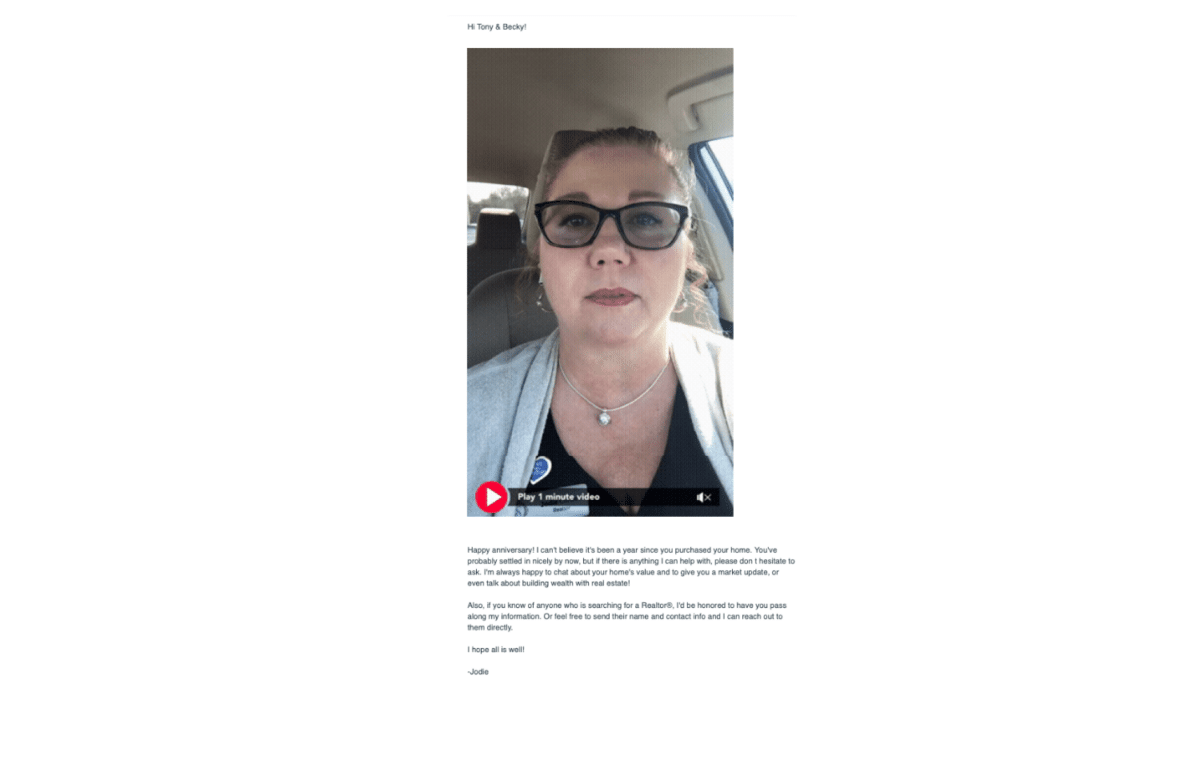
By making compliance and best practices a priority, you can build trust with your database, avoid legal issues, and achieve better email marketing results. Always put your readers’ preferences and experiences first to maintain a positive sender reputation and maximize the impact of your campaigns.
FAQs
Does email marketing work in real estate?
Absolutely! It’s the easiest way to keep track of all your leads, no matter where they come from or what stage of the buying or selling process they are in. Email marketing helps nurture all your leads so you can convert more of them and keep your pipeline growing with potential buyers and sellers.
How do you write a real estate marketing email?
The best way to write a real estate marketing email is to use email templates as a starting point. Then, customize them to sound more like you. Be sure to use the drip campaign templates preloaded into your CRM.
What email do real estate agents use?
Agents should use a business email from their website instead of a Gmail or similar email. Business accounts get a higher delivery rate since many spammers use cloud-based email servers like Google.
What is direct mail marketing in real estate?
Direct mail marketing is precisely what it sounds like—marketing mail delivered directly to your customers’ mailboxes. When marketers refer to direct marketing, they’re usually talking about direct communication with the customer instead of going through a mass media channel, like social media or television ads. Direct mail usually refers to postcards or anything the U.S. Postal Service delivers. Email marketing is another platform for direct marketing, but it’s much more cost-effective than direct mail.
Bringing It All Together
Email marketing helped me build my entire real estate business from nothing when I first started six years ago. I can’t think of a more cost-effective way to build any business. I love it! It may seem like a lot to understand, but hopefully, this complete guide will help shed some light on the technical parts and get you started using email marketing for real estate. Once you get going, I know you’ll see the benefits right away.
Are you using real estate email marketing in your business? What tips do you have? Did I miss anything? Be sure to let me know in the comments!












Add comment